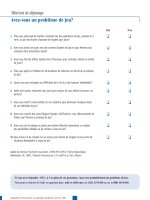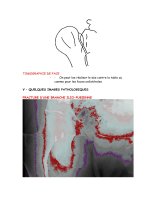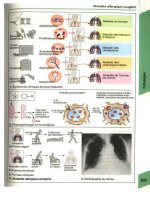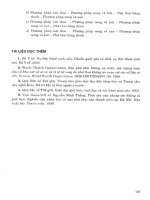Understanding Cosmetic Laser Surgery - part 8 pot
Bạn đang xem bản rút gọn của tài liệu. Xem và tải ngay bản đầy đủ của tài liệu tại đây (178.77 KB, 11 trang )
What Is It Like to Be Treated with a Surgical Laser? / 65
Pain is surprisingly mild after full-face CO
2
laser resurfacing.
Most of my patients report very little pain as early as one day
after resurfacing. As the skin heals, there is more often a feeling
of tightness (due to skin contraction), especially around the
mouth area. Most patients also report itching after several days,
usually correlated with regrowth of the epidermis over most of
the face.
Most patients largely heal within ten days. For several days after
the epidermis has re-grown, there is significant peeling of the epi-
dermis, producing a dry appearance. This flaky skin is treated with
an ointment type moisturizer (Aquaphor). The great majority of
patients are able to return to work within two weeks after resurfac-
ing. There is always redness (erythema), which has the appearance
of a sunburn. This redness will fade to pink but is usually maximal
about one month following surgery. By two months following sur-
gery, the pink color will be much lighter and usually fades com-
pletely within three to four months.
Incisional Laser Surgery
A special application of the CO
2
laser is its use as a cutting or
incisional instrument. This laser can be operated in a continuous
wave (CW) mode, in which the laser is not pulsed but is constantly
on while it is being used. If the laser energy is focused on a very
small point (typically 0.1 millimeter), the beam will cut through
skin or other tissues much as would a scalpel. There is one major
difference, however. The CO
2
laser coagulates (denatures) the tissue
due to the heat generated as water molecules absorb the laser
energy. All tissue structures are coagulated, including blood vessels.
The result is a bloodless incision. A regular scalpel does not cause
coagulation and invariably produces copious bleeding as it cuts
through skin and other tissues. The bloodless surgery possible with
the CO
2
laser can be a significant advantage during any cosmetic
surgery that requires incision of tissue; it is particularly well suited
to blepharoplasty (eyelid lift).
66 / What Is It Like to Be Treated with a Surgical Laser?
Blepharoplasty
Frequently, with aging, excessive skin and/or fat accumulates
around the eyelids. There are normally fat pads above and below the
eyeball called orbital fat pads. These pads function as shock
absorbers and cushion the eye from sudden movement or force. A
connective tissue structure called the orbital septum normally pre-
vents these fat pads from bulging forward or protruding above the
skin surface. With aging, most people will experience a weakening
of the orbital septum, which allows the orbital fat pads to protrude.
The protrusion can be very pronounced in the lower eyelid, pro-
ducing heavy bags that may cause the person to look poorly rested.
In the upper eyelids, the usual problem is excessive skin. This
skin excess can be quite extensive and will result in redundant folds
of skin that cover the lid itself and sometimes even the eyelashes. The
excess appears to be the result of actual stretching of the skin as well
as a lowering of the position of the eyebrows due to gravitational
forces and the downward pull of the muscles that cause frowning.
Redundant upper eyelid skin produces a tired or sad look to the eye
and reduces the apparent size of the eyes. Women with excessive upper
eyelid skin find it difficult to apply eye makeup because the redun-
dant fold of skin covers the platform of eyelid skin. Additional
fullness of the upper lids may be caused by bulging orbital fat pads,
as often occurs in the lower lids.
The goal of blepharoplasty is to surgically remove excessive skin
and fat by direct excision. Because there are abundant blood vessels
in the eyelid area, a traditional (scalpel) blepharoplasty will gener-
ally cause a great deal of bruising and swelling. In contrast, when
the CO
2
laser is used, blepharoplasty is generally a bloodless proce-
dure. Any bruising is usually the result of the needle used to inject
anesthetics, not the surgical cutting. The patient in fig. 6.5 is shown
before and six days after CO
2
laser blepharoplasty.
In upper eyelid blepharoplasty, excessive skin is removed via an
elliptical shape excision. Before any anesthesia is given, the redundant
skin is carefully measured and the planned incisions are marked (for
an example of these markings, see fig. 6.5). The excessive skin usually
What Is It Like to Be Treated with a Surgical Laser? / 67
Fig. 6.5 This patient underwent CO
2
laser blepharoplasty to remove
redundant skin and excessive fat in the upper eyelids. She is shown
a) before surgery, b) with marking for planned removal of skin, and
c) six days after blepharoplasty, with stitches removed and SteriStrips
placed over the incision line. Notice that the skin removal extends
slightly onto the temple and that there is minimal swelling or bruising
six days later.
68 / What Is It Like to Be Treated with a Surgical Laser?
extends laterally to the outer corner of the eye and the skin excision
must include this lateral skin. The size and shape of this skin excision
is the most important factor that determines the aesthetic quality of
the surgical result. After the skin surface is marked, the eyelids are
numbed with a local anesthetic injection. Special eye shields, much
like contact lenses, are placed directly on the eye surface after it has
been numbed with anesthetic eye drops. Next, the focused CO
2
laser
is used to slice through the eyelid skin. Some of the superficial herni-
ated orbital fat is removed by slicing off fragments using the laser. The
opening in the skin is stitched together to re-approximate the skin
edges. Ice packs are applied for several hours after the surgery to chill
the skin, constricting blood vessels and reducing swelling.
Stitches are removed by the seventh postoperative day (fig. 6.5).
With proper technique there is a minimal scar along the suture line.
Because upper eyelid skin heals extremely well, this scar should be
virtually undetectable to the casual observer (fig. 6.6).
In the lower eyelids, the primary problem that occurs with
aging is bulging of the orbital fat pads as opposed to the presence
of excessive skin. In lower lid blepharoplasty, the herniated, superfi-
cial portions of the fat pads are removed. Excessive skin, if present,
is best removed by laser resurfacing, which results in contraction of
this skin. Using a focused CO
2
laser instead of a scalpel for bleph-
aroplasty offers the significant advantage of bloodless surgery,
affording the surgeon better visualization of important anatomic
structures.
The safest approach to lower lid blepharoplasty is to access the
fat pads through an incision of the conjunctiva (inner lining) of the
lower lid, rather than through the skin. This transconjunctival
approach has two major advantages over the skin approach. Because
the fat pads lie behind the orbital septum (connective tissue layer),
this septum must be traversed if the skin approach is used.
Unfortunately, the orbital septum frequently heals by contracting
excessively, possibly resulting in a permanent pulling down of the
lower eyelid. Such pulling down can cause an unnatural shape to
the eye or may reveal the white of the eye below the iris, also an
unnatural appearance. With the transconjunctival technique, the fat
What Is It Like to Be Treated with a Surgical Laser? / 69
pads are accessed without traversing the orbital septum, thus avoid-
ing the potential problem of contraction of the septum.
The other advantage of the transconjunctival technique for lower
lid blepharoplasty is that it avoids a skin incision, which may heal
with an observable scar. Compared to upper lid incisions, lower lid
skin is more likely to scar when it heals. The transconjunctival
approach totally prevents this possibility. Because the biggest risk of
blepharoplasty is postoperative bleeding around the eye, the CO
2
laser method is much safer than traditional non-laser techniques.
Fig. 6.6 This 60-year-old patient is shown before and after CO
2
laser bleph-
aroplasty. Note the excessive upper eyelid skin and fat tissue in the preoperative
photograph. In the postoperative photograph, note the considerably more
“open eyed” look as well as the inconspicuous scar from the skin excision.
7. Complementary
Procedures to Cosmetic
Laser Surgery
Many cosmetic laser surgery procedures are used in conjunction
with non-laser cosmetic procedures because the effect of two or more
procedures may be significantly greater than the effect of a single
procedure. Different procedures frequently work through entirely
different mechanisms. Taking advantage of different mechanisms of
improvement can achieve optimal results. Some complementary
procedures can be done at the same time; others ideally should be
done in sequence, with one preceding the other by several weeks
or months.
Procedures Done in Advance of
Laser Resurfacing
There are several procedures, both surgical and nonsurgical, that
complement laser resurfacing. Most of these complementary proce-
dures can be performed either before or after the resurfacing, but I
generally prefer to do them prior to resurfacing.
For patients with extensive sun damage, full-face resurfacing
with the CO
2
laser is perhaps the single cosmetic surgery that can
result in the greatest overall facial rejuvenation (see chapter 6 and
figs. 6.3 and 6.4). The tightening of facial skin that results from this
procedure can even afford some improvement in the loose skin of
the neck. (The neck itself can also be resurfaced, but neck skin heals
more slowly and is at significantly increased risk of scarring if resur-
faced.) The majority of patients who are candidates for full-face
Complementary Procedures to Cosmetic Laser Surgery / 71
laser resurfacing are middle-aged or older and have significant
cosmetic problems in the neck area. Frequently there is excessive fat
in the anterior neck below the chin, sometimes resulting in a double
chin. Most patients will also have a prominence of the lower cheek
(jowl) area, also due to excessive fat. The neck and jowls usually sag
because of stretching of both the skin and the underlying fascia.
With advanced sagging of these tissue layers the neck will have a
“turkey gobbler” look. Some people have prominent bands running
along the vertical axis of the neck, caused by a redundancy of a super-
ficial muscle (the platysma muscle).
Most patients with cosmetic problems in the neck area require
liposuction for rejuvenation of this area. I usually perform liposuc-
tion of both neck and jowl areas, because most patients have exces-
sive fatty tissue in both. Those patients who have relatively little
sagging of the lower cheeks and neck but who have excess fat in
these areas may require only liposuction. Those who have significant
sagging will generally also need to have a facelift procedure (see
below). I perform both of these procedures using the tumescent
technique of local anesthesia. With this method, the subcutaneous
tissue (the fat layer) is diffusely infiltrated with a dilute solution of
local anesthetic in saline (salt water). The solution contains the
anesthetic lidocaine, which completely numbs the area, and epi-
nephrine, which causes significant constriction of the blood vessels.
Tumescent local anesthesia has several major advantages. It is extre-
mely safe, because the effects of the anesthesia are confined to the
local area of infiltration, and there are no systemic effects from these
drugs. Because the local blood vessels are constricted, there is mini-
mal bleeding during surgery and thus very little postoperative bruis-
ing and swelling. Recovery from surgery is very rapid because of the
minimal bruising and swelling.
Liposuction of the neck and jowls and facelift are conveniently
performed simultaneously and generally prior (one month or more)
to full-face laser resurfacing. These procedures cannot be done
simultaneously with laser resurfacing because, after liposuction and/
or facelift, a chin strap–style compression garment, which covers
much of the cheek area, must be worn for a few days. This garment
72 / Complementary Procedures to Cosmetic Laser Surgery
would interfere with the postoperative care needed after laser resur-
facing. Recovery after liposuction of the neck and jowls and/or
facelift is very rapid, with most patients able to resume normal
activities, including work, within one week of surgery. The patient
in fig. 7.1 underwent liposuction of the neck and jowls, followed
12 months later by full-face laser resurfacing.
In most patients with redundant platysma muscle, I perform a
corset platysmaplasty procedure along with liposuction of neck and
jowls. This procedure is essentially a “facelift for the neck” because
the platysma muscle layer is continuous with the fascia on the face
that is tightened during a facelift. The only anesthesia needed for
platysmaplasty is the same local (tumescent) anesthesia that is used
for liposuction. Immediately after liposuction of the neck and jowls,
a small horizontal skin incision is made in the transverse crease that
lies just below the chin. Through this incision, scissors are used to
Fig. 7.1 This 74-year-old patient had prominent fat in the neck and jowls
(lower cheek) areas and underwent liposuction of these areas. She subse-
quently received full face laser resurfacing.
Complementary Procedures to Cosmetic Laser Surgery / 73
separate the skin from the underlying flat platysma muscle. The edges
of the left and right platysma muscles are stitched together with a con-
tinuous suture, much like an old-fashioned corset. Stitching together
the muscle edges provides tightening of this layer and is very effective
at smoothing the neck and eliminating the platysma bands.
Many patients with excessive laxity of the lower face and neck tis-
sues benefit from a facelifting procedure. A newer technique, devel-
oped in Europe, is the S-lift minimum incision facelift. I frequently
use this technique in combination with liposuction of the neck and
jowls, with or without corset platysmaplasty, using entirely local
tumescent anesthesia. The S-lift technique is analogous to the
platysmaplasty in the neck, in that the goal is to tighten the fascia
(SMAS) layer. In the S-lift small skin incisions (shaped like the letter S)
are made in front of each ear; next, a dissection is made in the fatty
layer just beneath the skin of the lateral cheek and lateral neck. The
fascia layer is then pulled in an upward direction from the lateral neck
toward the ear and is anchored to the periosteum (a tough connective
tissue layer) of a bone in front of the ear, using permanent suture mate-
rial. Another stitch is used to tighten the SMAS layer of the cheek,
pulling it up and sideways toward the ear. A small amount of excess
cheek skin is excised and the skin is then stitched together.
I have found that the S-lift minimum incision facelift results in
remarkable improvement and achieves most of the results of a stan-
dard facelift. Compared to conventional facelift surgery, this mini-
facelift has several advantages. One is that this procedure can be
done entirely with local anesthesia. Other advantages include mini-
mal bruising and swelling and a very rapid recovery, usually in only
a few days. (In fact, some of my patients have returned to work
three days after the S-lift procedure.) With the S-lift, surgery is lim-
ited to safe areas of the face, virtually eliminating the risk of damage
to nerves or blood vessels that is associated with traditional facelifts.
Another advantage of the S-lift is that the only visible part of the
skin incision is immediately in front of the ear, generally within a
natural crease and thus inconspicuous. In contrast, the traditional
facelift produces a much larger and longer scar that extends onto
the neck and scalp behind the ear.
74 / Complementary Procedures to Cosmetic Laser Surgery
The combination of liposuction of neck and jowls and/or S-lift
minimum incision facelift followed by full-face laser resurfacing can
result in complete rejuvenation of the mid-to-lower face and neck
areas entirely through minimally invasive procedures using only
local anesthesia.
Another procedure that would ideally precede full-face laser
resurfacing and is sometimes performed in conjunction with a lower
eyelid blepharoplasty is the lateral canthal tendon suspension. This
procedure is done in those patients who have excessively lax lower
eyelids and who are at risk of developing, or may already have,
ectropion, a condition in which the lower eyelid is excessively loose
and may even be chronically separated from contact with the sur-
face of the eye. This procedure is well suited to a focused CO
2
laser
technique and can also be performed using only local anesthesia. An
incision is made in the temple area near where the upper and lower
eyelids come together, and the tendon that runs along the lower
eyelid margin is anchored to the fibrous tissue just above the bony
layer. Because the CO
2
laser is used, this procedure is bloodless and
produces less swelling and faster healing than that experienced with
conventional scalpel surgery.
Botox Injection: A Nonsurgical Method for
Reducing Facial Wrinkles
Botulinum toxin (Botox) is a medication with the unique prop-
erty of relaxing muscles after direct injection into the muscle. This
medication is a purified protein produced by clostridium botulinum,
the bacterium that causes botulism. Botulism occurs in humans
when they are exposed to large doses of botulinum toxin, usually by
ingesting food that has been contaminated with the bacterium. The
disease can be fatal if large amounts of the toxin are ingested because
the toxin causes paralysis of all muscles, including those required for
breathing. Extremely small doses of botulinum toxin are effective
at safely paralyzing the muscles into which it is injected (without
Complementary Procedures to Cosmetic Laser Surgery / 75
producing any systemic effect because it does not reach other parts
of the body). The paralysis produced by Botox injection is tempo-
rary (3–6 month duration).
At the nerve ending between motor nerve cells and skeletal mus-
cle cells, molecules of the neurotransmitter acetylcholine are released
from the nerve cell and migrate to the muscle cell where they attach
to a surface receptor and activate muscle contraction. Botulinum
toxin enters the nerve cells and destroys proteins that are needed for
the release of acetylcholine. The toxin permanently disables the nerve
endings and the muscle cell becomes paralyzed. Over the next few
months, however, new, normally functioning nerve endings grow from
the nerve cell, eventually restoring the cell’s ability to release acetyl-
choline and stimulate muscle contraction. The muscle will then
function normally until the next injection of Botox.
Most facial wrinkles occur as a result of repeated contraction of
muscles of expression (fig. 2.4). Botox injection will produce signifi-
cant improvement in wrinkles and furrows, partly because opposing
muscles that have not been treated tend to pull the skin in a direc-
tion that actively smoothes the wrinkles during the months that
Botox is active.
Botox was first approved by the FDA in 1989 as a treatment for
spastic eye and neck muscles. In 2002, it was approved for cosmetic
use to relax the small muscles that cause frowning. Studies are under
way for non-cosmetic uses of Botox, including treating migraine
headaches, inhibiting excess sweating, relaxing spastic urinary blad-
der (a common cause of incontinence), and even treating obesity by
relaxing the muscles of the stomach wall to slow gastric emptying.
Botox is administered by injection with a small needle directly
into the muscles to be treated. The most common side effect is
bruising from the needle. Another risk is unintended paralysis of
nearby muscles because of diversion of the toxin from the site of
injection. The most common example of this problem is drooping
of the eyelid after injection of frown muscles. Patients who are preg-
nant or nursing should not receive Botox, not should patients with
myasthenia gravis, a neurological disease that may be worsened by
treatment.









